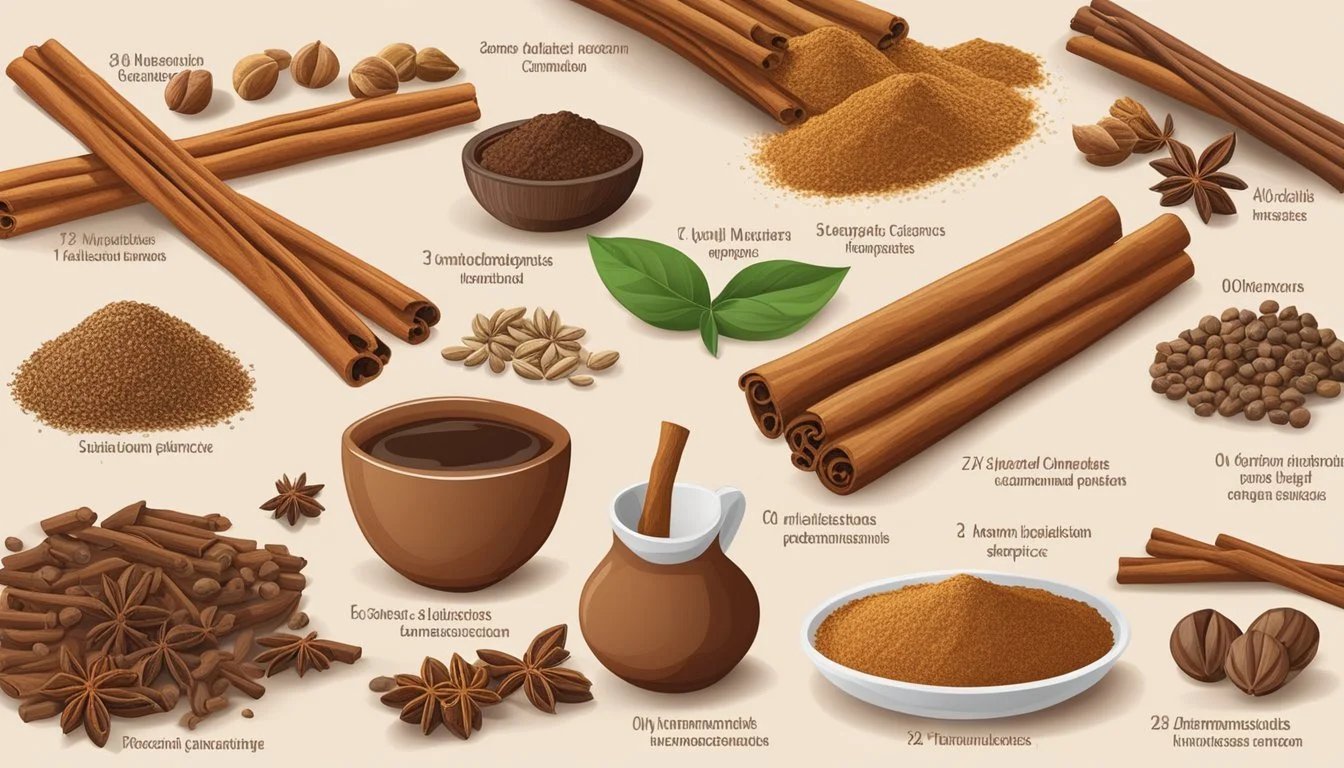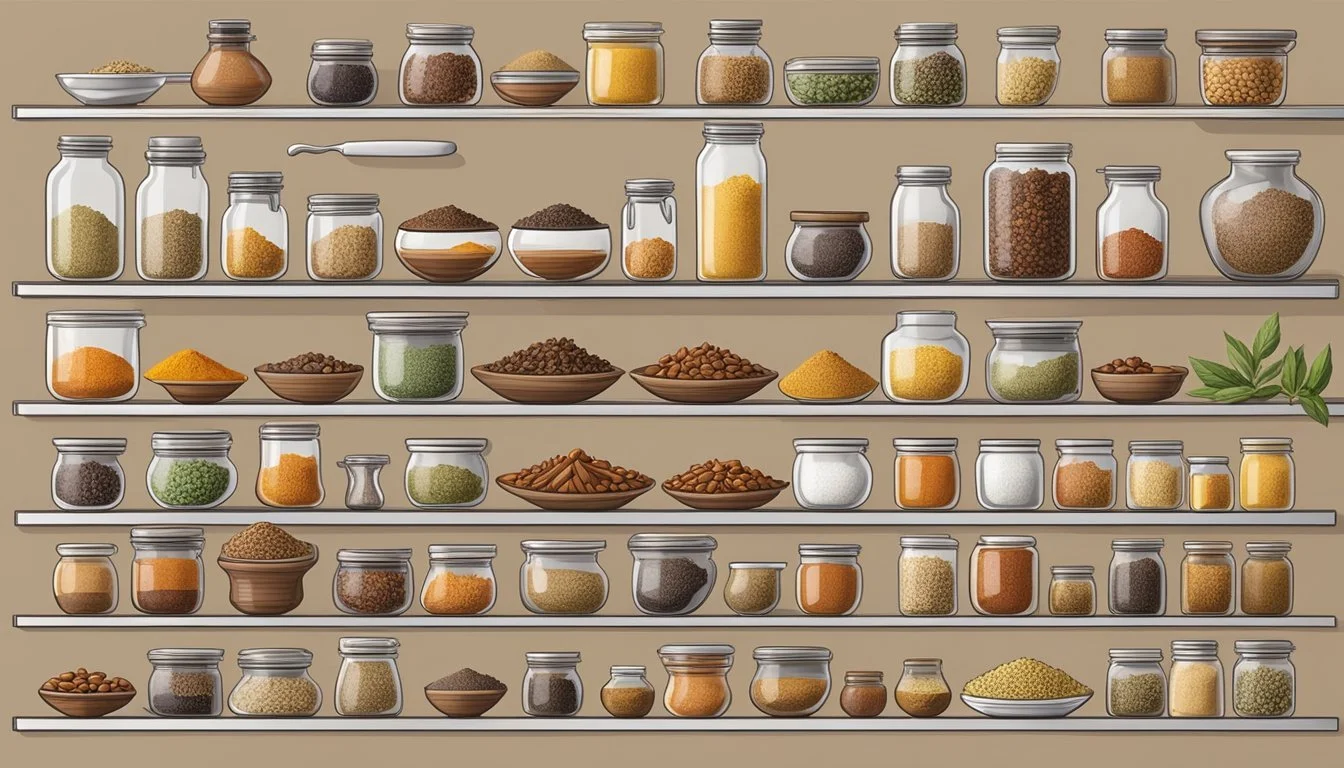Cinnamon Substitutes
Top Alternatives for Baking and Cooking
Cinnamon is a highly popular spice known for its sweet and warm flavor, appealing aroma, and multiple culinary applications. It is a staple in a variety of dishes ranging from desserts to savory meals, and it contributes significantly to the characteristic taste of many seasonal treats. However, there are moments when cinnamon may not be readily available in the kitchen, or when someone might be looking for an alternative due to dietary restrictions or personal taste preferences.
In such situations, there are several substitutes that can be used to mimic or complement the flavor that cinnamon typically provides. Ginger, for example, can offer a similar warm sensation to dishes and works well as a one-to-one substitute in recipes. Other spices such as nutmeg and allspice also share the warming nature of cinnamon and offer their unique profiles that can closely emulate cinnamon's role in both sweet and savory contexts. These alternatives not only help maintain the intended flavor balance but can also add their distinct nuances to a dish, enhancing its complexity and appeal.
Understanding Cinnamon
Cinnamon is a widely appreciated spice, derived from the inner bark of trees from the genus Cinnamomum. Historically significant and still cherished today, cinnamon is utilized in a variety of culinary and medicinal applications. It imparts a warm, sweet, and slightly spicy flavor to dishes.
Types of Cinnamon:
Cassia Cinnamon: Originates primarily from China and is the darker, more commonly found variety.
Ceylon Cinnamon: Also known as true cinnamon, Ceylon is lighter in color and possesses a milder, sweeter taste.
Korintje and Saigon Cinnamon: Both are variants of Cassia, with Saigon being particularly strong and spicy.
Ceylon vs. Cassia:
Ceylon is considered to be of higher quality and has a more nuanced flavor profile, often preferred by culinary experts.
Cassia is more accessible and has a bolder taste, which can dominate a dish.
Allergies: While relatively uncommon, some individuals may experience a cinnamon allergy, which can manifest as an adverse reaction to proteins found in the spice. Allergic responses can range from mild to severe and should be taken into consideration when serving food with cinnamon.
As cinnamon contains inherent qualities that contribute to its distinctive flavor, finding an equivalent substitute can be challenging. Substitution often depends on the particular recipe and desired outcome. Knowing the type and intended use of cinnamon is crucial for making an informed selection of an alternative, especially for those with cinnamon allergies or preferences between Ceylon and Cassia varieties.
Why Substitute Cinnamon?
Substituting cinnamon becomes necessary under certain circumstances such as health concerns, allergies, or simply to achieve a different taste profile in cooking and baking.
Health Reasons
Cinnamon, known for its antioxidant and anti-inflammatory properties, is often incorporated into diets to achieve potential health benefits. However, individuals with specific health conditions may seek substitutes to avoid exacerbating certain issues. Overconsumption of cinnamon, particularly the Cassia variety which contains coumarin, could potentially lead to liver damage or other complications when ingested in large quantities. People monitoring their coumarin intake would thus opt for an alternative spice.
Allergy and Sensitivities
A cinnamon allergy is an uncommon but possible trigger for those sensitive to this spice. Such allergies can manifest with symptoms ranging from skin irritations to digestive distress. Those diagnosed with a cinnamon allergy must avoid it entirely and seek safe replacements to eliminate the risk of an allergic reaction.
Different Flavor Profiles
While cinnamon imparts a signature warmth and aroma, some recipes may benefit from a variation in flavor profiles. Chefs and cooks might select substitutes to introduce earthy notes or a nutty flavor that are less dominant than the boldness of cinnamon. Each alternative brings its own unique taste and aromatic qualities to a dish, allowing for creativity and customization in culinary endeavors.
Common Cinnamon Substitutes
If one finds themselves without cinnamon, there are several viable substitutes to consider for maintaining a similar flavor profile in recipes. These alternatives can provide warmth, sweetness, and a depth of flavor akin to cinnamon.
Nutmeg is a well-regarded alternative, often used in a quarter of the amount initially intended for cinnamon. It offers a nutty and slightly sweet taste which is especially suitable for sweet dishes. Allspice, featuring a blend of nutmeg, cloves, and cinnamon notes, can also replace cinnamon in equal measure.
Ginger, available in fresh or powdered form, can be used on a one-to-one basis with cinnamon to bring a warm and slightly spicy flair to dishes.
Cloves, another spice with a warm and slightly astringent quality, should be used sparingly due to their potent flavor; a small amount can go a long way in echoing the intended impact of cinnamon.
Blends like pumpkin pie spice and apple pie spice naturally contain cinnamon, making them an easy alternative. They typically include a combination of spices such as cinnamon, allspice, ginger, and nutmeg, with the former often incorporating cloves as well.
For a more direct substitute, cinnamon extract can be an effective liquid option, providing a concentrated burst of cinnamon flavor.
Spice Substitute Ratio to Cinnamon Profile Notes Nutmeg 1/4 amount Nutty, subtle sweetness Allspice Equal amount Combination of several spice notes Ginger 1:1 ratio Warm, zesty Cloves Use sparingly Potent, astringent Pumpkin Pie Spice As needed Includes cinnamon, plus additional spices Apple Pie Spice As needed Blend of cinnamon-centric spices
Less common but equally compelling alternatives include cardamom, mace, and star anise, each offering unique flavors that can complement the dish as cinnamon would. Cardamom provides a citrusy and floral touch, mace brings a milder version of nutmeg's flavor, and star anise imparts a licorice-like taste with a hint of sweetness.
Using Cinnamon Substitutes in Cooking
When cooking without cinnamon, it's essential to consider the dish's flavor profile and choose a substitute that complements the ingredients. The right substitute can mimic cinnamon's warm, spicy notes or add a new dimension to the dish.
Savory Dishes
In savory dishes, ingredients like cumin can offer an earthy flavor akin to cinnamon's warmth, especially in Indian cuisine. Ground allspice and nutmeg are also used to enhance the complexity of recipes like curries. For instance:
Cumin: A pinch can replace cinnamon for its warmth in Indian and Middle Eastern savory dishes.
Sweet Dishes
For sweet dishes that typically rely on cinnamon's unique sweetness and warmth, apple pie spice and pumpkin pie spice are excellent substitutes. These blends often contain cinnamon combined with other spices like nutmeg and allspice; they are particularly suitable for:
Desserts like pies and baked fruit dishes.
Use sparingly for a balanced sweetness.
Baking
When baking, precise flavors and textures are crucial. Substitutes for cinnamon need to provide similar outcomes in sweet desserts. Options include:
Nutmeg: Provides a nutty sweetness; use half the amount.
Allspice: Offers a full-bodied warmth; use one-fourth the amount.
Drinks
Cinnamon often imparts a touch of spice in drinks. Whether in coffee, mulled wine, or other alcohol-based drinks, alternatives must not overpower the original intent. Suitable options include:
Ground Allspice: Adds depth to apple ciders and mulled beverages.
Nutmeg: Offers a layer of complexity, especially in coffee-based drinks.
How to Choose the Best Substitute
When looking for an alternative to cinnamon, one must consider both the flavor harmony and the physical characteristics of the substitute. The best replacement will closely mimic the original's flavor profile and texture for the recipe at hand.
Flavor Matching
Flavor profiles: When choosing a substitute for cinnamon, an individual should first consider the flavor profile they want to achieve. Cinnamon offers a sweet, warm, and woody aroma with hints of clove and citrus. A suitable replacement should have similar flavor notes to blend seamlessly into the dish.
Ginger: This substitute provides a warm flavor similar to cinnamon, though it can impart more heat and sharpness.
Cardamom: Often suggested as a one-to-one substitute due to its sweet and spicy notes.
Nutmeg: Carries a warmth with a slightly sweeter undertone and can be more pungent, so a 1/4 ratio is recommended.
Allspice: Resembles a blend of cloves, nutmeg, and cinnamon flavors; use in a 1:1 ratio or less to avoid overpowering the dish.
Texture and Form
Physical characteristics: The form of the cinnamon used in a recipe—whether ground cinnamon, cinnamon sticks, or cinnamon powder—influences both the intensity and distribution of flavor and should influence the choice of substitute.
Ground substitutes: For recipes calling for ground cinnamon, opt for a powdered form of the substitute to maintain consistency.
Cinnamon stick substitute: When a dish requires cinnamon sticks, choose whole spices that can be grated or infused into preparations, such as whole nutmeg or cardamom pods.
Ratios and Considerations: It's key to adapt the amount used based on the potency of the substitute. A general guideline is to start with less and adjust to taste, as most substitutes possess a stronger flavor than cinnamon.
Preparing Cinnamon Substitutes
When a recipe calls for cinnamon and none is at hand, preparing an adequate substitute involves selecting a spice with a compatible flavor profile and ensuring it is properly ground to match the recipe's texture requirements.
Grinding Spices
The key to effectively substituting cinnamon lies in the proper texture of the spice used. Whole spices maintain their flavor longer than pre-ground versions, making them ideal for grinding fresh as needed. A coffee grinder serves as an excellent tool for achieving a fine grind, though a mortar and pestle can also be employed for more control over the consistency.
To substitute cinnamon, one could choose among spices like nutmeg, allspice, or ginger due to their warm and aromatic qualities. Below is a guide on how to grind each spice for use as a cinnamon substitute:
Nutmeg: Given its hard texture, nutmeg requires a sturdy grinder. The amount should be reduced when substituted for cinnamon; a ratio of 1/4 teaspoon of ground nutmeg for every 1 teaspoon of cinnamon is generally recommended.
Allspice: Similar to nutmeg, allspice berries are hard and need to be ground finely. As allspice has an intense flavor, use 1/4 teaspoon for every teaspoon of cinnamon needed.
Ginger: Dried ginger can be used in a 1:1 ratio with cinnamon and should be ground until it reaches a texture similar to that of ground cinnamon. Fresh ginger has a different texture and moisture content and should not be used as a direct substitute in recipes calling for ground cinnamon.
Conclusion
When one is out of cinnamon or seeks a different flavor profile, there are multiple substitutes that can be used to achieve a desired culinary effect. Nutmeg and allspice appear as popular alternatives, offering a warm and slightly sweet taste. Ginger, an accessible option, provides a similar warmth with a distinct sharpness that complements a variety of dishes.
Cardamom stands out with its complex, slightly earthy flavor, making it suitable for sophisticated recipes. Another substitute, cloves, offers a pungent and sweet taste. One must use these alternatives judiciously, as their intense flavors can easily overpower a dish.
Table of Common Cinnamon Substitutes and Characteristics:
Substitute Flavor Note Best Used In Nutmeg Warm, sweet Baked goods, beverages Allspice Similar to cinnamon Sweet and savory dishes Ginger Warm, sharp Baked goods, Asian cuisine Cardamom Earthy, complex Desserts, Middle Eastern dishes Cloves Pungent, sweet Spice mixes, meat dishes
It is important to consider the flavor profile of the dish and the strength of these substitutes when using them in place of cinnamon. They are not only emergency stand-ins but also exciting alternatives that can bring a new dimension to traditional recipes.




